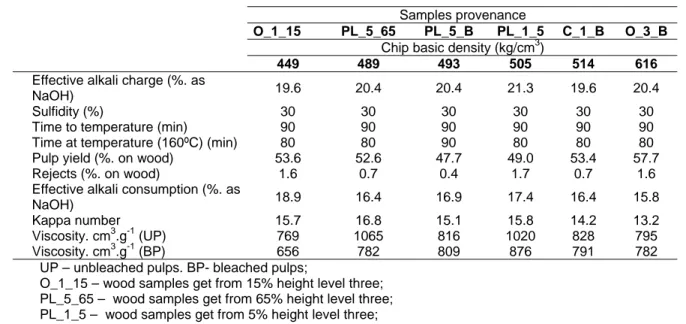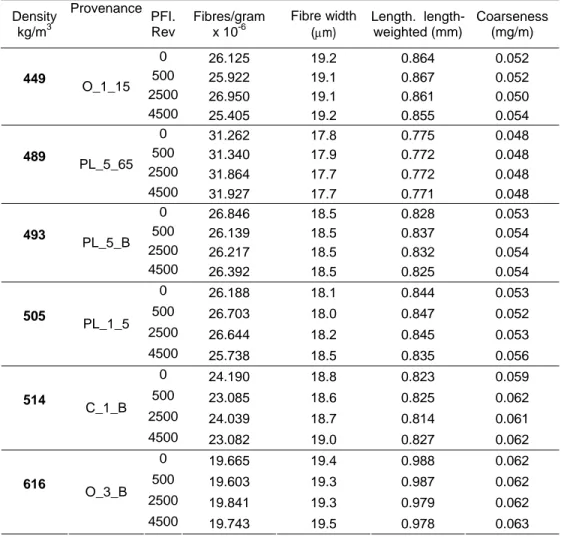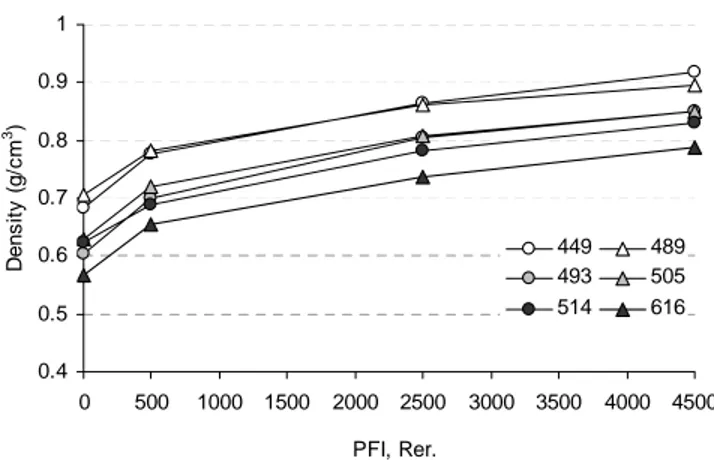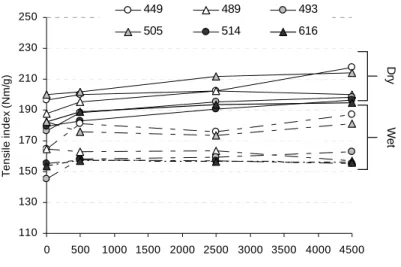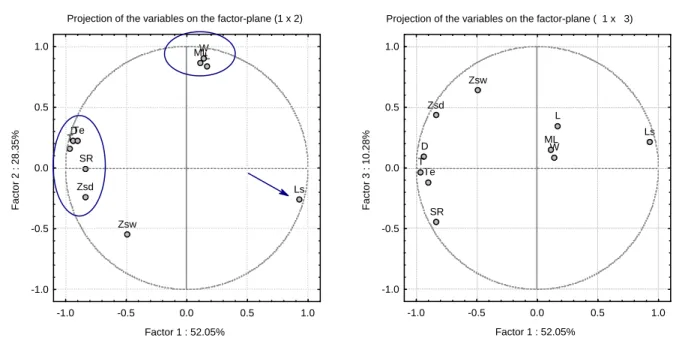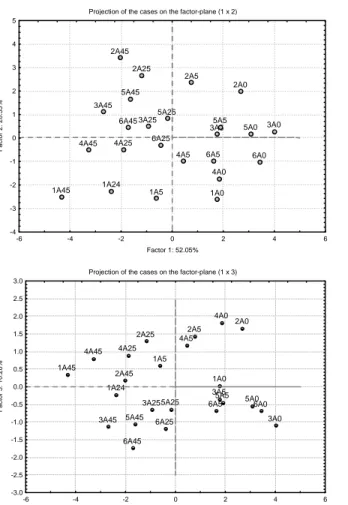EFFECT OF Acacia melanoxylon WOOD DENSITY ON PAPERMAKING
POTENTIAL
Carla Delgado1, António Santos2, Rogério Simões2 and Ofélia Anjos1,3
1
Escola Superior Agrária de Castelo Branco, Quinta da Senhora de Mércules, Apartado 119 – 6001 Castelo Branco – Portugal, ofelia@esa.ipcb.pt
2
Research Unit of Textile and Paper Materials, Universidade da Beira Interior, 6201-001 Covilhã – Portugal,
antonio.santos@efn.com.pt, rog.simoes@ubi.pt
3
Centro de Estudos Florestais, Instituto Superior de Agronomia, 1349-017 Lisboa, Portugal.
SUMMARY
In this work we study the behaviour in kraft cooking and papermaking of 6 Acacia melanoxylon wood chip samples, with basic densities of 449, 489, 493, 505, 514 and 616 kg/m3. The wood chip samples were screened and submitted to the kraft cooking process. Experiments were carried out with 1000-g o.d. of wood in a forced circulation digester. The cooked chips were disintegrated, screened and washed. The screened and total yields, kappa number and pulp viscosity were determined according to the standard methods. The morphological properties of pulp fibres were determined by image analysis of a diluted suspension in a flow chamber in Morfi®. The unbleached kraft pulps were submitted to a bleaching D0E1D1E2D2 sequence and their papermaking potential evaluated. The pulps were beaten in a PFI mill at 500, 2500 and 4500 revolutions under a refining intensity of 1.7 N/mm. Paper handsheets were prepared according to the Scan standard and tested regarding structural, mechanical and optical properties.
Regarding the pulping potential, the pulp yield ranged between 47.7 and 57.7%. The selected wood samples provided bleached kraft pulps with markedly different biometrics characteristics. In fact, the mean values of fibre length, fibre width and coarseness ranged between 0.77 and 0.98 mm, 17.8 and 19.4 µm, 4.8 and 6.2 mg/100m, respectively. As expected, these biometrics characteristics have very high impact on paper structure, including smoothness, and on mechanical and optical properties, for the unbeaten pulps. At a given beaten level, the differences between pulps remain very high. Moreover, for a given paper density, tensile and tear strength, and light scattering coefficient are significantly different. To
reach a given paper density, however, the different pulps required very different energy consumptions in beating.
Key words: Acacia melanoxylon, wood basic density, papermaking potential, fibre characteristics
INTRODUCTION
Acacia melanoxylon R. Br., usually named Blackwood, grows spontaneously in Portugal. This species is well adapted to the Portuguese soil and climate and can grow in pure or mixed stands with other species namely Pinus pinaster Aiton.
The A. melanoxylon timber has good characteristic to be used for panelling, veneers, furniture, craftwood and it is universally regarded as an excellent interior feature timber. This species can also be used for pulp production and present good performance in different paper grades. Several authors have studied their pulping and paper making potential (Clark et al., 1991; Guigan et al., 1991; Furtado, 1994; Gil et al., 1999; Paavilainen, 2000; Santos et al., 2002; Santos et al., 2006a; Santos et al., 2006b). So, in Portugal Blackwood can be considered as an alternative raw material for sawmills and pulp industry. In addition, this species has a good annual increment (0.89 cm.ano-1) (Santos et al., 2006a), when compared with the maritime pine (0.58 to 0.85 cm.ano-1) (Tavares et al., 2004) and eucalypt (0.84 to 0.96 cm.ano-1) (Tomé et al., 2001), that are the most representative species in Portugal.
For the paper industry the raw material has good potential; at a given drainage resistance (30 ºSR), the papers produced with acacia (A. dealbata and A. melanoxylon) present higher apparent densities than eucalypt (0.80 to 0.66 g/cm3) (Santos et al., 2004) because their pulp fibres have lower coarseness and higher flexibility and collapsibility.fibre These fibres lead to papers with good relationship between light scattering and tensile strength, at low refining energy consumption (Santos et al., 2006b).
The relationships between paper properties and raw material properties, namely wood chip density, have been studied by several authors (Paavilainen 1989; Paavilainen, 2000; Downes et al., 2003; Kibblewhite et al., 2003; Santos et al., 2006c). On the other hand, it is very well documented that there is a quite high variability of the fibre morphology within trees, between trees within a stand, and between trees from different stands (Evans et al., 1999; Downes et al., 2003;), but no study for A. melanoxylon were carried out about this subject.
The objective of this work is to evaluate the influence of wood density and fibre morphology on beating development and on paper structure and corresponding paper properties.
MATERIAL AND METHODS
Six wood chip samples of A. melanoxylon were selected from a set of 120 samples, comprising 4 sites, 5 trees per site and 6 levels per tree. Considering both the wood density and the height levels in the trees, six samples were selected. The chip basic density was determined according to the Tappi 258 om-94 standard procedure. The wood chips (1000-g o.d.) were submitted to a conventional kraft cooking process, in a forced circulation digester, under the following reaction conditions: effective alkali charge - variable; sulfidity index - 30%; liquor/wood ratio - 4/1; time to temperature - 90 min; time at temperature (160 ºC) - variable. The cooked chips were disintegrated, washed, and screened on a L&W screen with 0.3 mm slot width. The accepted material was collected on a 200 mesh screen. The screened and total yields, kappa number and pulp viscosity were determined according to the standard methods. The brown-stocks were bleached according to the following bleaching sequence: D0E1D1E2D2.
The morphological properties of pulp fibres were determined automatically by image analysis of a diluted suspension (20 mg/L) in a flow chamber in Morfi®. The pulps were beaten in a PFI mill at 500, 2500 and 4500 revolutions under a refining intensity of 1.7 N/mm.
The water retention value (WRV) was determined according to the Silvy et al. procedure (13), in the suspension with and without fines; these were removed in the Bauer-McNett® apparatus, using a 100 mesh screen. Paper handsheets were prepared according to the Scan standard, and tested regarding structural, mechanical and optical properties.
RESULTS
The cooking conditions required by the 6 samples to produce kraft pulp with kappa number in the range of 13 to 17 were slightly different (Table 1). In particular, the wood sample with highest basic density exhibit the lowest alkali consumption and led to a pulp yield which is 4 -10 points higher than those exhibited by the other wood samples. This result is consistent with very high cellulose content of the wood sample. In addition, the pulp yields compare very well with those reported for E. globulus wood.The pulp
viscosities are lower then those reported by Santos et al. (2006) for the same species. These differences can be tentatively attributed to the higher alkali charge used in the cooking, but the effects of other factors are possible.
Table 1 – Cooking conditions and results.
Samples provenance
O_1_15 PL_5_65 PL_5_B PL_1_5 C_1_B O_3_B
Chip basic density (kg/cm3)
449 489 493 505 514 616
Effective alkali charge (%. as
NaOH) 19.6 20.4 20.4 21.3 19.6 20.4
Sulfidity (%) 30 30 30 30 30 30
Time to temperature (min) 90 90 90 90 90 90
Time at temperature (160ºC) (min) 80 80 90 80 80 80
Pulp yield (%. on wood) 53.6 52.6 47.7 49.0 53.4 57.7
Rejects (%. on wood) 1.6 0.7 0.4 1.7 0.7 1.6
Effective alkali consumption (%. as
NaOH) 18.9 16.4 16.9 17.4 16.4 15.8
Kappa number 15.7 16.8 15.1 15.8 14.2 13.2
Viscosity. cm3.g-1 (UP) 769 1065 816 1020 828 795
Viscosity. cm3.g-1 (BP) 656 782 809 876 791 782
UP – unbleached pulps. BP- bleached pulps;
O_1_15 – wood samples get from 15% height level three; PL_5_65 – wood samples get from 65% height level three; PL_1_5 – wood samples get from 5% height level three;
PL_5_B, C_1_B, O_3_B – wood samples acquire from the bottom of the different threes
Fibre properties
Table 2 shows the biometric characteristics of the fibres from the six pulps for the three beating levels. The pulp fibres obtained from the wood with the highest basic density have highest coarseness, highest width and highest length (length-weighted). Regarding to mean fibre length, the analysis of the values for the PL_1 tree shows that this morphological property decrease significantly with the height in the tree. On the other hand, the samples from the base of the trees exhibit in general significantly higher coarseness than the samples from the higher levels in the tree height. The exception is the sample PL_5_B, which also shows an extremely low pulp yield.
Table 2 - Fibre characteristics of unbeaten pulps. Density kg/m3 Provenance PFI. Rev Fibres/gram x 10-6 Fibre width
(μm) Length. length-weighted(mm)
Coarseness (mg/m) 0 26.125 19.2 0.864 0.052 500 25.922 19.1 0.867 0.052 2500 26.950 19.1 0.861 0.050 449 O_1_15 4500 25.405 19.2 0.855 0.054 0 31.262 17.8 0.775 0.048 500 31.340 17.9 0.772 0.048 2500 31.864 17.7 0.772 0.048 489 PL_5_65 4500 31.927 17.7 0.771 0.048 0 26.846 18.5 0.828 0.053 500 26.139 18.5 0.837 0.054 2500 26.217 18.5 0.832 0.054 493 PL_5_B 4500 26.392 18.5 0.825 0.054 0 26.188 18.1 0.844 0.053 500 26.703 18.0 0.847 0.052 2500 26.644 18.2 0.845 0.053 505 PL_1_5 4500 25.738 18.5 0.835 0.056 0 24.190 18.8 0.823 0.059 500 23.085 18.6 0.825 0.062 2500 24.039 18.7 0.814 0.061 514 C_1_B 4500 23.082 19.0 0.827 0.062 0 19.665 19.4 0.988 0.062 500 19.603 19.3 0.987 0.062 2500 19.841 19.3 0.979 0.062 616 O_3_B 4500 19.743 19.5 0.978 0.063 Papermaking potential
The evolution of the drainability resistance of the pulp suspension is represented in Fig. 1, for the six pulps studied. The different behaviors are clear even for the unbeaten pulps but are more impressive for the full beaten pulps. The experimental results clearly show that drainage resistance development decrease with wood density increase. Moreover, considering the wood chip
15 25 35 45 55 0 500 1000 1500 2000 2500 3000 3500 4000 4500 PFI, rev SR ° 449 489 493 505 514 616
Fig. 1: Evolution of the Schopper Riegler degree (ºSR) with
beating
for the A. melanoxylon pulps.provenance in the tree, we can verify that the pulps with the lower drainage resistance development (493, 514, and 616) are associated with the samples originated from the tree bottom. In addition, the lowest development of this property is associated with the highest fibre coarseness.
The experimental results of paper density (Fig. 2) reveals that the pulps produced from the wood chips with the lower basic density (449 and 489
kg/m3) exhibit values markedly higher than the pulps produced from wood samples with higher wood density. The pulp originated from the sample with both the highest wood basic density and pulp yield densify very hardly. Regarding mechanical properties, A. melanoxylon pulp produced with lowest density wood (wood chip 449 kg/m3) exhibits the highest tensile index (Fig. 3) at a given PFI
revolutions, and this performance remains over the beating period. In addition, these results are consistent with those observed for the paper density. In fact, papers with higher density have strong structures and consequently higher resistances. But if we observed the relation between the tensile index and paper density we can see that the papers produced with the wood chip with the highest density have the highest tensile index, but at the expense of higher energy consumption in beating.
0.4 0.5 0.6 0.7 0.8 0.9 1 0 500 1000 1500 2000 2500 3000 3500 4000 4500 PFI, Rer. D ens it y ( g /c m 3) 449 489 493 505 514 616
Fig. 2: Evolution of paper density with beating for the A. melanoxylon pulps. 0 20 40 60 80 100 120 0 500 1000 1500 2000 2500 3000 3500 4000 4500 PFI, Rer. T ens il e i nde x ( N m /g) 449 489 493 505 514 616 0 20 40 60 80 100 120 0.50 0.60 0.70 0.80 0.90 1.00 Density (g/cm3) T ens il e i nde x ( N m /g) 449 489 493 505 514 616
Fig. 3: Evolution of tensile index as a function of PFI revolutions (a-left) and paper density
(b-right) for the A. melanoxylon pulps.
The paper strength given by the zero-span tensile strength test (dry and wet) was represented in Figure 4 and seem to indicate a slightly decrease of this property for the wood fibres from the tree base. The reasons behind these observations are yet under investigation.
The papers produced with fibres with lower coarseness (fibres from lower wood density – 449 kg/m3) have a higher internal resistance. This could be explained by higher ability of these fibres for collapsing in the paper structure and developing inter-fibre bonding.
110 130 150 170 190 210 230 250 0 500 1000 1500 2000 2500 3000 3500 4000 4500 PFI, Rer. T e n s ile ind e x ( N m /g) 449 489 493 505 514 616 Dry We t
Fig. 4: Evolution of zero-span tensile strength, dry and wet, with PFI revolutions.
Light scattering coefficient is represented versus apparent paper density in Figure 5, where a very different behavior can be observed for the
tested wood samples. The light scattering ability decreases with the coarseness, as expected, because these fibres have lower specific surface area. Similar results where reported by Ludovina et al. (2005) with E. globulus. The mechanical treatment applied in the beating process diminishes the light scattering coefficient due to the improved links between fibres, fibrils and fines.
20.0 25.0 30.0 35.0 40.0 45.0 50.0 0.50 0.60 0.70 0.80 0.90 1.00 Density (g/cm3) L ig h t s c a tte ri n g c o e ffi c ie n t ( m 2/kg ) 449 489 493 505 514 616
Fig. 5: Evolution of light scattering coefficient as a function of PFI revolutions.
At the beginning of the beating process, the tear index values (Figure 6) increase significantly for all pulps, but this effect is more evident for the pulp originated from the wood samples with low density. Thereafter, the tear index increases very slowly or level off. For low beating levels the fibres are pulled out from the paper structure and the inter-fibre bonding play a positive role on tear resistance
development. For much higher beating levels, where intense inter-fibre bonding exists, the fibres are removed from the structure by fibre rupture, which can involve lower energy than fibre pulled out. On the other hand, the pulps with the fibres in the range of high coarseness exhibit lower tear resistance in consequence of the lower number of fibres per gram. However, the coarse fibres can exhibit good performance if the apparent paper density is considered as a reference (Fig. 6-b).
Fig. 6: Evolution of tear index as a function of PFI revolutions (a-left) and paper density (b-right).
The results of ANOVA analysis show that the effect of wood density on all paper properties are significant (P<0.001) and represent an important amount of the total variance. For the paper density the percentage of variance is higher than for the other studied properties.
Variance explained by principal components analysis
In this work we used principal components analysis to investigate the differences in fibre characteristics and paper properties, as well as their interaction for the papers produced from wood chips with different densities. Three factors were chosen in this study because the 3rd one explains 10.3% of total variation and there are one variable that is well explain by this factor.
In Fig. 7 each point represents the mean of a given property, for the six pulp samples. The first component explains 52.1% and the second explains 28.4% of total variation.
0 2 0 500 1000 1500 2000 2500 3000 3500 4000 4500 PFI, Rer. T 4 6 8 10 12 ear i n dex ( m N .m 2/g ) 449 489 493 505 514 616 4.0 6.0 8.0 10.0 12.0 ear i n dex ( m N .m 2/g ) 449 489 0.0 2.0 0.50 0.60 0.70 0.80 0.90 1.00 Density (g/cm3) T 493 505 514 616
Projection of the variables on the factor-plane (1 x 2) D SR T L W ML Te Zsd Zsw Ls -1.0 -0.5 0.0 0.5 1.0 Factor 1 : 52.05% -1.0 -0.5 0.0 0.5 1.0
Projection of the variables on the factor-plane ( 1 x 3)
Figure 7 – Relative distribution of paper characteristics according to the factors resulting form multi-varied analysis components.
Factor 1, which defines the first component of paper properties, includes a series of properties, which are significantly correlated amongst themselves: paper density (D), Shopper degree (SR), tensile index (T), tear index (Te) and dry zero-span (Zsd). The light scattering coefficient (Ls) is also strongly correlated with the previous group but in inverse order. In fact, all the first variables showed a strong correlation with paper density and the way fibres connect to form papers with higher mechanical resistance. Similar results are observed by Santos et al. (2005) with acacia and eucalyptus papers. In Factor 2, components coarseness (ML), fibre width (W) and length (length-weighted) (L) have positive coefficients. The factor 3 was explained by the wet zero-span (Zsw), and this factor isn’t well correlated with the other variables.
We also projected the cases onto the same system of vectors. Figure 8 shows how the values of different wood chips density are correlated. The paper produced with wood chip density 449 kg/m3, 489 kg/m3, 505 kg/m3and 616 kg/m3 are clearly different between itself and the paper produced with wood chip density 493 kg/m3 and 514 kg/m3 don’t represent a higher differences between them but are different for the others.
Fac tor 2 : 28. 35% D SR T L W ML Te Zsd Zsw Ls -1.0 -0.5 0.0 0.5 1.0 -1.0 -0.5 0.0 0.5 1.0 Fac tor 3 : 10. 28% Factor 1 : 52.05%
Projection of the cases on the factor-plane (1 x 2) 1A0 1A5 1A24 1A45 2A0 2A5 2A25 2A45 3A0 3A5 3A25 3A45 4A0 4A5 4A25 4A45 5A0 5A5 5A25 5A45 6A0 6A5 6A25 6A45 -6 -4 -2 0 2 4 6 Factor 1: 52.05% -4 -3 -2 -1 0 1 2 3 4 5
Projection of the cases on the factor-plane (2 x 3)
-2.5 -2.0 -1.5 -1.0 -0.5 0.0 0.5 1.0 1.5 2.0 2.5
Figure 8 – Projection diagram of the cases on the factor plane.
CONCLUSION
The experimental results obtained in this work have shown that wood density is an important predictor of the fibre morphology and papermaking potential. The wood samples with very high wood density provide coarse fibres that develop beating slowly and produce bulky paper structures. At a given paper density, however, these pulp fibres can produce papers with very good performance in terms of tensile strength but poor tear resistance. Moreover, these fibres have relatively low specific surface area and provide papers with low light scattering ability. On the contrary, the wood samples with moderate wood density provide pulp fibres with lower coarseness, which develop beating and densify more easily, and perform better in papermaking.
Factor 2: 28.35% 1A0 1A5 1A24 1A45 2A0 2A5 2A25 2A45 3A0 3A5 3A25 3A45 4A0 4A5 4A25 4A45
5A05A55A25 5A45 6A06A5 6A25 6A45 -4 -3 -2 -1 0 1 2 3 4 5 Factor 3: 10.28% Factor 2: 28.35%
Projection of the cases on the factor-plane (1 x 3)
-3.0 -2.5 -2.0 -1.5 -1.0 -0.5 0.0 0.5 1.0 1.5 2.0 2.5 3.0 1A0 1A5 1A24 1A45 2A0 2A5 2A25 2A45 3A0 3A5 3A25 3A45 4A0 4A5 4A25 4A45 5A0 5A5 5A25 5A45 6A0 6A5 6A25 6A45 -6 -4 -2 0 2 4 6 Factor 3: 10.28% Legend:
The number before A represents the wood chip density: 1 for the lowest and 6 for the highest; the number after A represents the refining intensity, 0 – 0; 5 – 500; 25 -2500 and 45 –4500 revolutions.
BIBLIOGRAPHY
Clark B., Balodis V., Guigan F., Jingxia W. (1991) Pulping properties of tropical acacias. Proc. Int. Workshop on Advances in tropical acacia research, Bangkok, p.138
Downes. G.. Evans. R.. Wimmer. R.. French. J.. Farrington. A. and Lock. P. (2003) Wood. pulp and handsheet relationships in plantation grown Eucalyptus globulus. Appita J. 56(3): 221
Evans. R.. Kibblewhite. R.P. and Lausberg. M. (1999) Relationships between wood and pulp properties of twenty-five 13 year old radiate pine trees. Appita J. 52(2): 132
Furtado P. (1994) Caracterização de acácias e estudo da sua incorporação na produção de pasta. Internal Report of Raiz-Instituto de Investigação da Floresta e Papel, Aveiro, Portugal.
Gil C., Amaral Mª E., Tavares M., Simões R. (1999) Estudo do potencial papeleiro da Acacia spp”. In Proc. 1º Encontro sobre Invasoras lenhosas, Gerés, Portugal, p. 171.
Guigan F., Balodis V., Jingxia W., Clark N.B. (1991) Kraft pulping properties of Acacia mearnsii and A. silvestris. Proc. Int. Workshop on Advances in tropical acacia research, Bangkok, p.145
Kibblewhite. R.P.. Evans. R. and Riddell. M.J.C. (2003) Interrelationships between kraft handsheets. and wood fibre and chemical properties for the trees and logs of 29 Eucalyptus fastigata and 29 E. nitens. Proc. 57th Appita Ann. Gen. Conf.. Melbourne. p. 99
Ludovina F., Santos, A., Amaral E., Anjos, O., Simões, 2005. Características biométricas das pastas de Eucalyptus globulus produzidas a partir de madeira de diferentes densidades. Tecnicelpa XIX encontro Nacional Inovação e Competitividade, Tomar, 20-23 de Abril, p:25-32.
Paavilainen. L. (1989) Effect of sulphate cooking parameters on the papermaking potential of pulp fibres. Paperi ja Puu – Paper and Timber. 71 (4): 356
Paavilainen L. (2000) Quality-competitiveness of Asian short-fibre raw materials in different paper grades. Paperi já Puu – Paper and Timber, 82 (3): 156
Paavilainen. L. (2000) Quality-competitiveness of Asian short-fibre raw materials in different paper grades. Paperi ja Puu – Paper and Timber. 82 (3): 156
Santos A., Anjos A., Simões R. (2002) Estudo preliminar sobre o potencial papeleiro da Acacia spp.. In II Congresso Ibero-Americano de pesquisa e desenvolvimento de produtos florestais, I seminário em tecnologia da madeira e produtos florestais não-madeiráveis, Curitiba, Brasil, in Cd-room.
Santos A, Simões R. and Anjos O., 2005. Principal component analysis as a tool to correlate properties of different laboratorial papers. XV International Papermaking Conference, Efficiency of papermaking and paper converting processes, in Cd Room. Wroclaw, Poland, 28-30 September.
Santos A., Teixeira A., Anjos O., Simões R., Nunes L., Machado J., Tavares M. (2006a) Utilização potencial do lenho de Acacia melanoxylon a crescer em povoamentos puros ou mistos com Pinus pinaster pela indústria florestal portuguesa. In Press
Santos A., Anjos O., Simões R. (2006b) Papermaking potential of Acacia dealbata and Acacia melamoxylon. Appita J. 59(1): pp. 58-64.
Santos A., Amaral, M.E., Anjos O., Simões R., 2006c. Effect of Eucalyptus globulus wood density on papermaking potential. Submitted to TAPPI Journal - May 2006
Tavares M. (2004) 2º Relatório de execução material do Projecto POCTI/42594/AGR/2001 - Valorização do lenho de acácia produzido em Portugal. Potenciais utilizações. FCT/INIAP Lisboa.
Tomé M., Ribeiro F., Soares P. (2001) O modelo GLOBULUS 2.1. RTC-GIMREF nº1/2001. Instituto Superior de Agronomia – Departamento de Engenharia Florestal. Lisboa.
